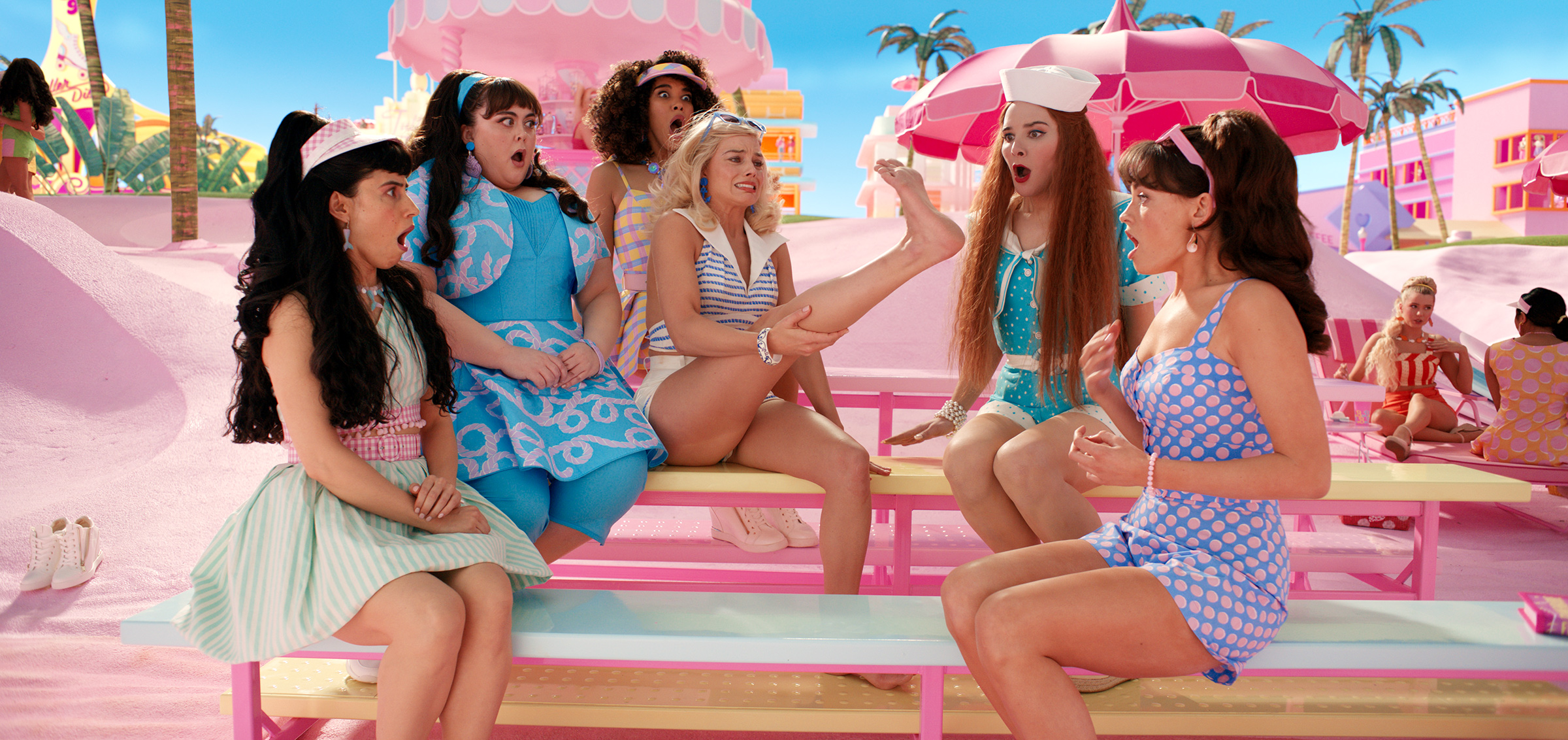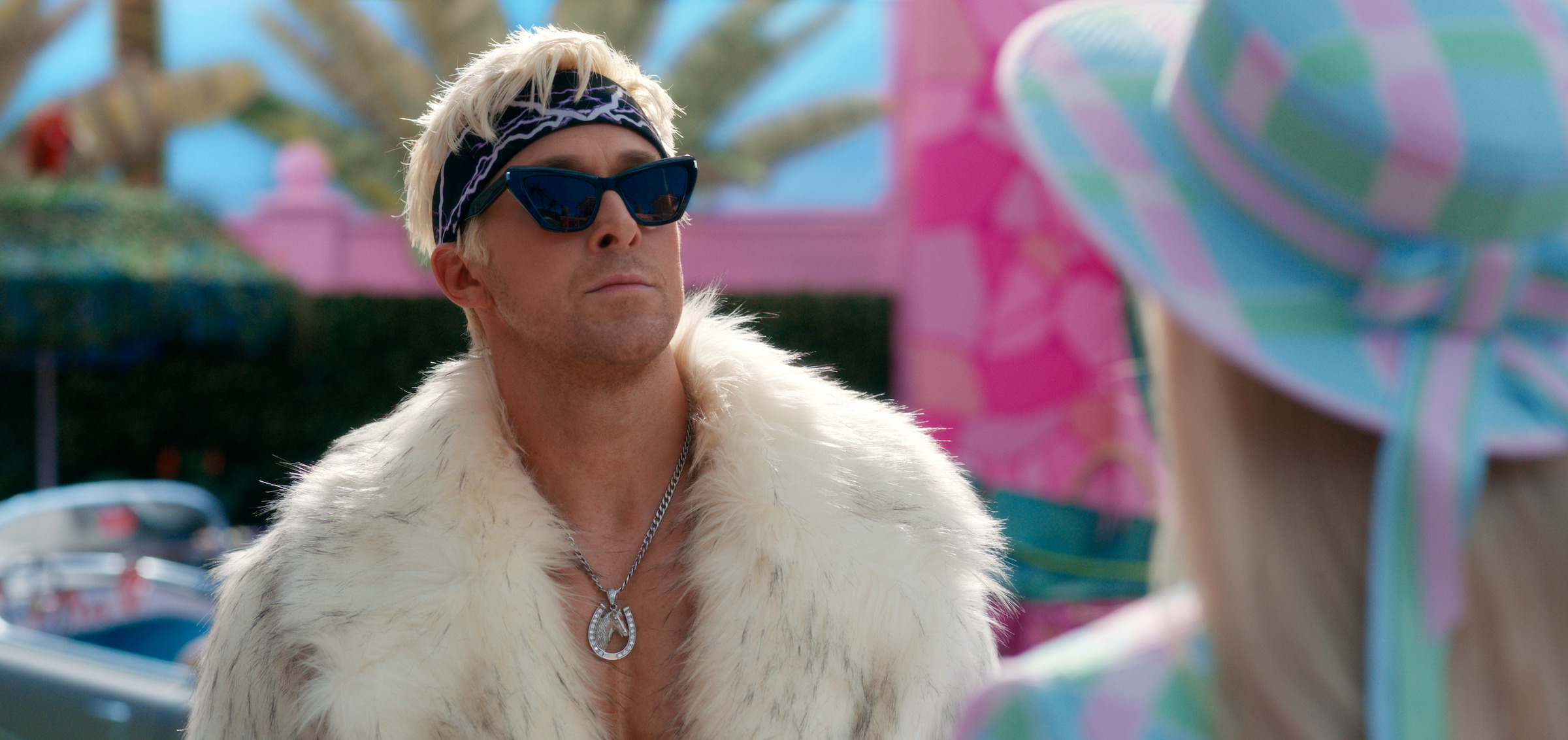The fallacy of Barbie the doll is that she’s supposed to be both the woman you want to be and your friend, a molded chunk of plastic—in a brocade evening dress, or a doctor’s outfit, or even Jane Goodall’s hyper-practical safari suit—which is also supposed to inspire affection. But when you’re a child, your future self is not a friend—she’s too amorphous for that, and a little too scary. And you may have affection, or any number of conflicted feelings, for your Barbie, but the truth is that she’s always living in the moment, her moment, while you’re trying to dream your own future into being. Her zig-zagging signals aren’t a problem—they’re the whole point. She’s always a little ahead of you, which is why some love her, others hate her, and many, many fall somewhere in the vast and complex in-between.
With Barbie the movie—starring Margot Robbie, also a producer on the film—director Greta Gerwig strives to mine the complexity of Barbie the doll, while also keeping everything clever and fun, with a hot-pink exclamation point added where necessary. There are inside jokes, riffs on Gene Kelly-style choreography, and many, many one-line zingers or extended soliloquies about modern womanhood—observations about all that’s expected of us, how exhausting it all is, how impossible it is to ever measure up. Gerwig has done a great deal of advance press about the movie, assuring us that even though it’s about a plastic toy, it’s still stuffed with lots of ideas and thought and real feelings. (She and Noah Baumbach co-wrote the script.) For months now there has been loads of online chatter about how “subversive” the movie is—how it loves Barbie but also mocks her slightly, and how it makes fun of Mattel executives even though their real-life counterparts are both bankrolling the whole enterprise and hoping to make a huge profit off it. The narrative is that Gerwig has somehow pulled off a coup, by taking Mattel’s money but using it to create real art, or at least just very smart entertainment.
Read More: Our Cover Story on Barbie
It’s true that Barbie does many of the things we’ve been promised: there is much mocking and loving of Barbie, and plenty of skewering of the suits. But none of those things make it subversive. Instead, it’s a movie that’s enormously pleased with itself, one that has cut a big slice of perfectly molded plastic cake and eaten it—or pretend-eaten it—too. The things that are good about Barbie—Robbie’s buoyant, charming performance and Ryan Gosling’s go-for-broke turn as perennial boyfriend Ken, as well as the gorgeous, inventive production design—end up being steamrollered by all the things this movie is trying so hard to be. Its playfulness is the arch kind. Barbie never lets us forget how clever it’s being, every exhausting minute.
That’s a shame, because the first half-hour or so is dazzling and often genuinely funny, a vision that’s something close to (though not nearly as weird as) the committed act of imagination Robert Altman pulled off with his marvelous Popeye. First, there’s a prologue, narrated by Helen Mirren and riffing on Stanley Kubrick’s 2001, explaining the impact of early Barbie on little girls in 1959; she was an exotic and aspirational replacement for their boring old baby dolls, whose job was to train them for motherhood—Gerwig shows these little girls on a rocky beach, dashing their baby dolls to bits after they’ve seen the curvy miracle that is Barbie. Then Gerwig, production designer Sarah Greenwood, and costume designer Jacqueline Durran launch us right into Barbieland, with Robbie’s approachably glam Barbie walking us through. This is an idyllic community where all the Dream Houses are open, not only because its denizens have no shame and nothing to hide, but because homes without walls mean they can greet one another each day with the sunrise. “Hello, Barbie!” they call out cheerfully. Everyone in Barbieland—except the ill-fated pregnant Midge, based on one of Mattel’s many discontinued experiments in toy marketing—is named Barbie, and everyone has a meaningful job. There are astronaut Barbies and airline pilot Barbies, as well as an all-Barbie Supreme Court. Garbage-collector Barbies, in matching pink jumpsuits, bustle cheerfully along this hamlet’s perpetually pristine curbs. This array of Barbies is played by a selection of actors including Hari Nef, Dua Lipa, Alexandra Shipp, and Emma Mackey. The president is also Barbie—she’s played by Issa Rae. (In one of the early section’s great sight gags, she brushes her long, silky tresses with an overscale oval brush.)

Barbieland is a world where all the Barbies love and support one another, like a playtime version of the old-fashioned women’s college, where the students thrive because there are no men to derail their self-esteem. Robbie’s Barbie—she is known, as a way of differentiating herself from the others, as Stereotypical Barbie, because she is white and has the perfectly sculpted proportions and sunny smile of the Barbie many of us grew up with—is the center of it all. She awakens each morning and throws off her sparkly pink coverlet, her hair a swirl of perfectly curled Saran. She chooses an outfit (with meticulously coordinated accessories) from her enviable wardrobe. Her breakfast is a molded waffle that pops from the toaster unbidden; when she “drinks” from a cup of milk, it’s only pretend-drinking, because where is that liquid going to go? This becomes a recurring gag in the movie, wearing itself out slowly, but it’s delightful at first, particularly because Robbie is so game for all of it. Her eyes sparkle in that vaguely crazed Barbie-like way; her smile has a painted-on quality, but there’s warmth there, too. She steps into this role as lightly as if it were a chevron-striped one piece tailored precisely to her talents.
Barbie also has a boyfriend, one Ken of many Kens. The Kens are played by actors including Kingsley Ben-Adir and Simu Liu. But Gosling’s Ken is the best of them, stalwart, in a somewhat neutered way, with his shaggy blond hair, spray-tan bare chest, and vaguely pink lips. The Kens have no real job, other than one known as “Beach,” which involves, as you might guess, going to the beach. The Kens are generally not wanted at the Barbies’ ubiquitous dance parties—the Barbies generally prefer the company of themselves. And that’s why the Kens’ existence revolves around the Barbies. As Mirren the narrator tells us, Barbie always has a great day. “But Ken has a great day only if Barbie looks at him.” And the moment Robbie does, Gosling’s face becomes the visual equivalent of a dream Christmas morning, alight with joy and wonder.
Sign up for Worth Your Time for weekly recommendations on what to read, watch, and listen to.
You couldn’t, of course, have a whole movie set in this highly artificial world. You need to have a plot, and some tension. And it’s when Gerwig airlifts us out of Barbieland and plunks us down in the real world that the movie’s problems begin. Barbie awakens one morning realizing that suddenly, nothing is right. Her hair is messy on the pillow; her waffle is shriveled and burnt. She has begun to have unbidden thoughts about death. Worst of all, her perfectly arched feet have gone flat. (The other Barbies retch in horror at the sight.) For advice, she visits the local wise woman, also known as Weird Barbie (Kate McKinnon), the Barbie who’s been “played with too hard,” as evidenced by the telltale scribbles on her face. Weird Barbie tells Robbie’s confused and forlorn Barbie that her Barbieland troubles are connected to something that’s going on out there in the Real World, a point of stress that turns out to involve a Barbie-loving mom, Gloria (America Ferrera), and her preteen daughter, Sasha (Ariana Greenblatt), who are growing apart. Barbie makes the journey to the Real World, reluctantly allowing Ken to accompany her. There, he’s wowed to learn that men make all the money and basically rule the land. While Barbie becomes more and more involved in the complexity of human problems, Ken educates himself on the wonders of the patriarchy and brings his newfound ideas back to empower the Kens, who threaten to take over the former utopia known as Barbieland.

By this point, Barbie has begun to do a lot more telling and a lot less showing; its themes are presented like flat-lays of Barbie outfits, delivered in lines of dialogue that are supposed to be profound but come off as lifeless. There are still some funny gags—a line about the Kens trying to win over the Barbies by playing their guitars “at” them made me snort. But the good jokes are drowned out by the many self-aware ones, like the way the Mattel executives, all men (the head boob is Will Ferrell), sit around a conference table and strategize ways to make more money off selling their idea of “female agency.”
The question we’re supposed to ask, as our jaws hang open, is “How did the Mattel pooh-bahs let these jokes through?” But those real-life execs, counting their doubloons in advance, know that showing what good sports they are will help rather than hinder them. They’re on team Barbie, after all! And they already have a long list of toy-and-movie tie-ins on the drawing board.
Meanwhile, we’re left with Barbie the movie, a mosaic of many shiny bits of cleverness with not that much to say. In the pre-release interviews they’ve given, Gerwig and Robbie have insisted their movie is smart about Barbie and what she means to women, even as Mattel executives have said they don’t see the film as being particularly feminist. And all parties have insisted that Barbie is for everyone.
Barbie probably is a feminist movie, but only in the most scattershot way. The plot hinges on Barbie leaving her fake world behind and, like Pinocchio and the Velveteen Rabbit before her, becoming “real.” Somehow this is an improvement on her old existence, but how can we be sure? The movie’s capstone is a montage of vintagey-looking home movies (Gerwig culled this footage from Barbie’s cast and crew), a blur of joyful childhood moments and parents showing warmth and love. Is this the soon-to-be-real Barbie’s future, or are these the doll-Barbie’s memories? It’s impossible to tell. By this point, we’re supposed to be suitably immersed in the bath of warm, girls-can-do-anything fuzzies the movie is offering us. Those bold, bored little girls we saw at the very beginning of the film, dashing their baby dolls against the rocks, are nowhere in sight. In this Barbieland, their unruly desires are now just an inconvenience.
More Must-Reads from TIME
- Donald Trump Is TIME's 2024 Person of the Year
- Why We Chose Trump as Person of the Year
- Is Intermittent Fasting Good or Bad for You?
- The 100 Must-Read Books of 2024
- The 20 Best Christmas TV Episodes
- Column: If Optimism Feels Ridiculous Now, Try Hope
- The Future of Climate Action Is Trade Policy
- Merle Bombardieri Is Helping People Make the Baby Decision
Contact us at letters@time.com